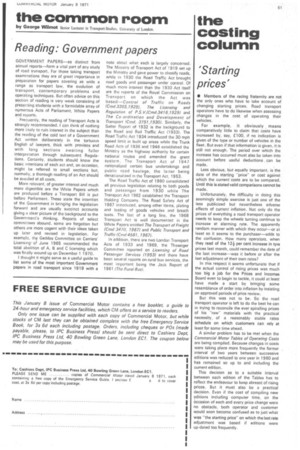Reading: Government papers
Page 53

If you've noticed an error in this article please click here to report it so we can fix it.
GOVERNMENT PAPERS—as distinct from annual reports—form a vital part of any study of road transport. For those taking transport examinations they are of great importance in preparation for papers covering as wide a range as transport law, the evolution of transport, contemporary problems and operating techniques. But often advice on this section of reading is very weak consisting of presenting students with a formidable array of numerous Acts of Parliament, White Papers and reports.
Freauently, the reading of Transport Acts is strongly recommended. I can think of nothing more likely to ruin interest in the subject than the reading of the cold text of a Government Act written deliberately in the tortuous English of lawyers, thick with provisos and with long sections awaiting fuller interpretation through subsequent Regulations. Certainly, students should know the basic intentions of each act and, on occasion, might be referred to small sections but, normally, a thorough reading of an Act should be avoided at all costs.
More relevant, of greater interest and much more digestible are the White Papers which are produced before a Transport Bill is put before Parliament. These state the intention of the Government in bringing the legislation forward and are usually succinct accounts giving a clear picture of the background to the Government's thinking. Reports of select committees abound, some are forgotten but others are more cogent with their ideas taken up later and revised in legislation. For example, the Geddes Committee on Carriers' Licensing. of June 1965 recommended the total abolition of A, B and C licensing which was finally wound up on December 1 1970.
I thought it might serve as a useful guide to list some of the most important Government papers in road transport since 1919 with a
note about what each is largely concerned. The Ministry of Transport Act of 1919 set up the Ministry and gave power to classify roads, while in 1930 the Road Traffic Act brought road goods and passenger under control. Of much more interest than the 1930 Act itself are the reports of the Royal Commission on Transport on which the Act was based---Control of Traffic on Roads (Com1.3365,1929), The Licensing and Regulation of P.S.V.(Cmd.3416,1929) and The Co-ordination and Development of Transport (-Cmd. 3751,1930). Similarly, the Salter Report of 1932 is the background to the Road and Rail Traffic Act (1933). The Road Traffic Act 1934 introduced the 30 mph Speed limit in built up areas while the Trunk Road Acts 011936 and 1946 established the Ministry as the highway authority for certain national routes and amended the grant system. The Transport Act of 1947 nationalized certain bus undertakings and public road haulage, the latter being denationalized in the Transport Act, 1953.
The Road Traffic Act of 1960 consolidated all previous legislation relating to both goods and passenger from 1930 while The Transport Act 1962 established the Transport Holding' Company. The Road Safety Act of 1967 introduced, among other items, plating and testing of goods vehicles and breath tests. The last of a long line, the 1968 Transport Act is well documented in the White Papers entitled The Transport of Freight (Cmd 3470, 1967) and Public Transport and Traffic (Crocl 4581,1967).
In addition, there are two London Transport Acts of 1933 and 1969, the Theseiger Committee reported on Licensing of Road Passenger Services (7953) and there have been several reports on rural bus services, the most important being the Jack Report of 1961 (The Rural_ Bus).












































































































































